Ba<strong>de</strong>au V., Dupouey J.L., Cluzeau C., Drapier J., Le Bas C. (2004). Modélisation <strong>et</strong> cartographie <strong>de</strong>l’aire climatique potentielle <strong>de</strong>s gran<strong>de</strong>s essences forestières françaises. Rapport final, Carbofor.Séquestration <strong>de</strong> carbone dans les grands écosystèmes forestiers en France. Quantification,spatialisation, vulnérabilité <strong>et</strong> impacts <strong>de</strong> différents scénarios climatiques <strong>et</strong> sylvicoles. Vol<strong>et</strong> D1.Programme GICC, INRA Bor<strong>de</strong>aux, pages 101-111Bagu<strong>et</strong>te M. & Van Dyck H. (2007). Landscape connectivity and animal behavior: functional grain as akey <strong>de</strong>terminant for dispersal. Landscape ecology, vol.22, pages 1117-1129.Bagu<strong>et</strong>te M. & Van Dyck H. (2005). Dispersal behavior in fragmented landscapes: routine or specialmovement? Basic and Applied Ecology, vol.6, pages 535-545.Bagu<strong>et</strong>te M. (2004). The classical m<strong>et</strong>apopulation theory and the real natural world: a criticalappraisal. Basic and Applied Ecology, vol.5, pages 213-224.Baltzinger C., Barrier R., Picard M. & Boscardin Y. Proj<strong>et</strong> DIPLO (2009-201x) DIspersion <strong>de</strong>s PLantespar les Ongulés sauvages : approche comparative <strong>de</strong> 3 vecteurs le cerf, le chevreuil <strong>et</strong> le sanglier.Barb<strong>et</strong>-Massin M., Thuiller W. & Jigu<strong>et</strong> F. (2011). The fate of European breeding birds un<strong>de</strong>r climate,land-use and dispersal scenarios. Global Change Biology, vol.18, pages 881-890.Barthod C., Graffin V. & Deshayes M. (2011). Les trames <strong>verte</strong> <strong>et</strong> <strong>bleue</strong>, un proj<strong>et</strong> du Grenelle <strong>de</strong>l’environnement qui concerne les forestiers, Revue Forestière Française LXIII.Basilico L, Massu N. & Martin D. (2010). Changement climatique impacts sur le littoral <strong>et</strong>conséquences pour la gestion. Synthèse du séminaire <strong>de</strong>s 18 <strong>et</strong> 19 octobre 2010, Fréjus.Bastien Y. & Gauberville C. (coord.) (2011). Vocabulaire forestier. Ecologie, gestion <strong>et</strong> conservation<strong>de</strong>s espaces boisés. AgroParisTech, CNPF-IDF, ONF, ISBN : 978-2-904740-99-2, 555 pages.Baub<strong>et</strong> E., Vassant J., Brandt S. & Maillard D. (2007). Connaissances sur la biologie du sanglier :Utilisation <strong>de</strong> l’espace <strong>et</strong> régime alimentaire. ONCFS. Colloque sur les modalités <strong>de</strong> gestion dusanglier en France.Beier P. & Loe S. (1992). A checklist for evaluating impacts to wildlife movement corridors. WildlifeSoci<strong>et</strong>y Bull<strong>et</strong>in, vol.20, pages 434-440.Beier P. & Noss R.F. (1998). Do Habitat Corridors Provi<strong>de</strong> Connectivity? Conservation Biology, Vol.12,issue 6, pages 1241-1252.Benn<strong>et</strong> A.F., Henein K. & Merriam G. (1994). Corridor use and the elements of corridor quality:Chipmunks and fencerows in a farmland mosaic. Biological Conservation, vol.68, Issue 2, pages 155-165.Benn<strong>et</strong>t A.F. (1990). Habitat corridors and the conservation forest environment of small mammals ina fragmented landscape. Landscape Ecology, vol.4, pages 109-122.Bergès L., Roche P. & Avon C. (2010). Corridors écologiques <strong>et</strong> conservation <strong>de</strong> la biodiversité,intérêts <strong>et</strong> limites pour la mise en place <strong>de</strong> la <strong>Trame</strong> <strong>verte</strong> <strong>et</strong> <strong>bleue</strong>. Sciences Eaux <strong>et</strong> Territoires n°3.Berthoud G. & Müller S. (1994). Sécurité faune / trafics. Manuel pratique à l’usage <strong>de</strong>s ingénieurscivils. EPFL – Laboratoire <strong>de</strong>s voies <strong>de</strong> circulation. Saint-Sulpice, 124 pages.66
Bertoud G. (2010). Gui<strong>de</strong> méthodologique <strong>de</strong>s réseaux écologiques hiérarchisés. Conseil Générald’Isère.Bertrand R., Lenoir J., Piedallu C., Riofrío-Dillon G., <strong>de</strong> Ruffray P., Vidal C., <strong>et</strong> al. (2011). Changes inplant community composition lag behind climate warming in lowland forests. Nature, vol. 479, pages517-520.Birard C. (2006). Les chemins <strong>de</strong> la vie. Revue Espaces Naturels, n°14.Birot Y., Palahi, Mavsar R., Gracia C. (2008). Mediterranean Forests Un<strong>de</strong>r Focus. InternationalForestry Review ,vol.10 (4), page 676.Bodin J. (2010). Thèse : Observed changes in mountain veg<strong>et</strong>ation of the Alps during the XXthcentury, Role of climate and land-use changes. Université Henri Poincaré - Nancy I, UniversitätHannover.Bolger D. T., Scott A.T. & Rotenberry J.T. (2001). Use of corridors-like landscape structures by birdsand small mammal species. Biological Conservation, vol.102, pages 213-224.Bonenfant C. (2008). Dynamique <strong>de</strong>s populations <strong>de</strong>s grands herbivores: application au Cerf élaphe(Cervus elaphus). CNRS-LBBE, Lyon. Symposium Cerf, Avril 2008.Bontemps J-D. (2006). Evolution <strong>de</strong> la productivité <strong>de</strong>s peuplements réguliers <strong>et</strong> monospécifiques <strong>de</strong>hêtre (Fagus sylvatica L.) <strong>et</strong> <strong>de</strong> chêne sessile (Quercus p<strong>et</strong>raea Liebl.) dans la moitié Nord <strong>de</strong> la Franceau cours du XXe siècle. Doctorat Sciences Forestières, LERFoB, Paristech, ENGREF.Bracco & Prevost (2010). Atlas <strong>de</strong>s mammifères sauvages en Poitou-Charentes. Grand Rhinolophe(Rhinolophus ferrumequinum).Brown J.H. & Gibson A.C. (1983). Biogeography. Mosby, St. Louis, MO, page 643.Brubaker L.B. (1986). Responses of tree populations to climatic change. Veg<strong>et</strong>atio, vol.67, pages 119-130.Brückmann S.V., Krauss J., Steffan-Dewenter I. (2010). Butterfly and plant specialists suffer fromreduced connectivity in fragmented landscapes. Journal of Applied Ecology, vol. 47, Issue 4, pages799–809.Bugmann H. (1997). Sensitivity of forests in the European Alps to future climatic change. ClimateResearch, vol.8, pages 35-44.Burel F. & Baudry J. (1999). Ecologie du paysage: Concepts, métho<strong>de</strong>s <strong>et</strong> applications. Tec <strong>et</strong> Doc,Lavoisier, 360 pages.Cemagref & MEEDDM. (2010). Étu<strong>de</strong> <strong>de</strong> l’intégration <strong>de</strong>s continuités écologiques dans les SCoT en2009 avant l’approbation <strong>de</strong> la loi Grenelle 2. Partie I.Chaurand J. (2011). <strong>Trame</strong> <strong>verte</strong> <strong>et</strong> <strong>bleue</strong>, critères <strong>de</strong> cohérence interrégionale, nationale <strong>et</strong>transfrontalière. Réflexion sur la méthodologie à adopter pour définir <strong>de</strong>s listes d’’espèces végétales« déterminantes » <strong>Trame</strong> Verte <strong>et</strong> Bleue. Fédération <strong>de</strong>s Conservatoires Botaniques Nationaux.67


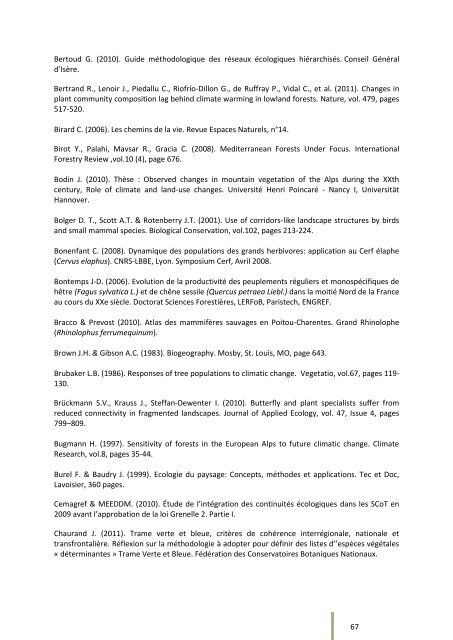
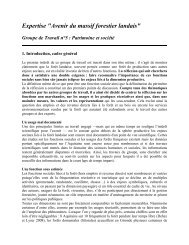
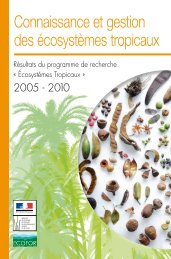
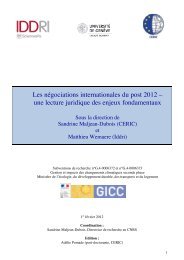


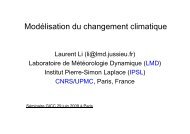

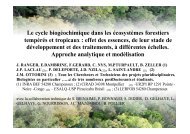


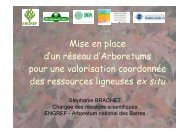
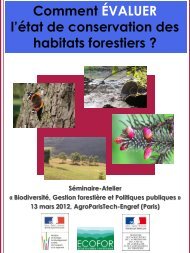
![3-Rochard [Mode de compatibilité] - GIP-Ecofor](https://img.yumpu.com/30840824/1/190x135/3-rochard-mode-de-compatibilitac-gip-ecofor.jpg?quality=85)
